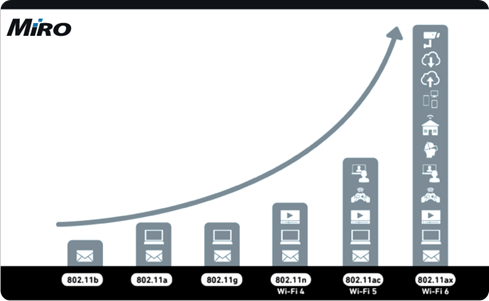Five reasons why your business needs Wi-Fi 6
- Tebogo Mphatswe
- Latest News
- 2 likes
- 2397 views
- 0 comments
There is little doubt that Internet connectivity has changed our lives forever. For the past 20 years, businesses have seen tremendous growth in how their teams use the internet to perform tasks, market themselves and communicate cross-functionally. Wi-Fi technology is the bedrock for further change as internet users expand their reliance and dependency on wireless connectivity.
The History of Wi-Fi
The term Wi-Fi was created by the Wi-Fi alliance back in April 2000. According to the alliance, more than 20 years later, over 15 billion Wi-Fi products are in use worldwide. Wi-Fi networks have evolved from pursuing connectivity and coverage to supporting high-capacity access to as many wireless clients as possible without interruptions or packet loss.

Why is Wi-Fi important for your business?
Wi-Fi technology can mean the difference between growth and stagnation in increasingly competitive and hostile industries, especially for small and medium-sized businesses with tight budgets looking for a serious bang for their buck. Using the most recent Wi-Fi technology (Wi-Fi 5 or Wi-Fi 6) as the primary connectivity method inside your business could increase productivity, satisfy employees, and delight customers. Over the years, Wi-Fi has boosted business mobility and efficiency and allowed companies to stay in touch with their customers for a seamless customer experience – at the office or home.
Five reasons why businesses should upgrade to Wi-Fi 6
Stock Availability in 2022
Wi-Fi was in for the perfect storm when the pandemic broke out. Significant increases in demand for consumer electronics and record-breaking supply-chain disruptions have been a massive cause for concern throughout 2021 and well into 2022, with no clear indication of when supply will be fully restored. Global semiconductor manufacturers have shifted their resources toward manufacturing Wi-Fi 6 chipsets at the cost of reduced capacity for manufacturing Wi-Fi 5 chips. This shift in supply has caused a significant sellout of Wi-Fi 5 products, with predictions of WiFi 5 chip challenges lasting into 2023. Knowing how dire this situation could be for local businesses, MiRO has increased its inventory of Wi-Fi 6 products to support the growth of local businesses and fill the gaps left by the shortage of Wi-Fi 5 products
Connecting more users/devices
Wi-Fi compatible devices have seen tremendous growth over the years. Our workplaces stand to benefit from the influx of internet-ready appliances such as printers, scanners, air conditioners and much more. With Voice-over-Wi-Fi finally moving past the bugs and jitters, VoIP and video for real-time communication have also increased exponentially. Our workforces are more mobile, bandwidth-demanding, and need high-speed Wi-Fi to empower their work further.
Increased Wi-Fi speeds
With users requiring higher capacity levels, antenna design became the cornerstone for innovation in Wi-Fi’s development. For starters, Wi-Fi 6 uses a maximum configuration of 8x8:8. More antennas allow for more concurrent connections, improved speeds, and minimised wireless network congestion, enabling multiple users to “talk” on the network simultaneously (this feature is also known as Multi-User Multiple Input Multiple Output or MU-MIMO). The previous version, Wi-Fi 5, could enable speeds of up to 1.2Gbps, but with Wi-Fi 6, we have seen wireless networks with close to 10Gbps. Perfect for growing businesses looking to take advantage of the Internet to extend their reach and improve their operations - all without installing network points in all offices and Wi-Fi access points every couple of meters.
Preparing for the Internet of Things (IoT)
Wi-Fi 6 has brought key technical enhancements for smart-home, office and industrial applications. With previous Wi-Fi standards, wireless devices were connected, or they weren’t. By comparison, Wi-Fi 6 has protocols to negotiate wake-up times with Wi-Fi 6 access points when they’re not in use. This frees up bandwidth on the network, theoretically leading to longer battery life in sensors supporting Wi-Fi 6. Target wake time (TWT) is an innovation in Wi-Fi 6 technology that lets devices plan communication with the router, so they aren’t always connected. This extends the battery life on smartphones, tablets and Wi-Fi 6 compatible internet of things sensors, allowing for a cleaner, electric cable-free office or home IoT network.
The standard is backwards compatible
You're all covered if you want to upgrade or add Wi-Fi 6 devices to an existing network. Laptops, smartphones, and other Wi-Fi-capable devices running previous generations of Wi-Fi will all be able to connect to your brand new Wi-Fi 6 network without any trouble. And as you upgrade these user devices over time, your Wi-Fi 6 network will get faster and more responsive. However, it is crucial to keep in mind that to experience the power of Wi-Fi 6 fully, you need to use Wi-Fi 6 compatible devices to connect to the network. The best way to improve your wireless network's performance, speed, coverage, and efficiency is to speak to the MiRO solution experts.
MiRO is a proud distributor of world-class Wi-Fi products. Whether you’re looking to build an enterprise network or simply upgrade a home network, MiRO has a solution for every environment. Browse through their diverse portfolio by heading through to their website, www.miro.co.za , or contact the sales team at sales@miro.co.za. Alternatively, you can call (or WhatsApp) them on 012 657 0960.


Comments
View Comments